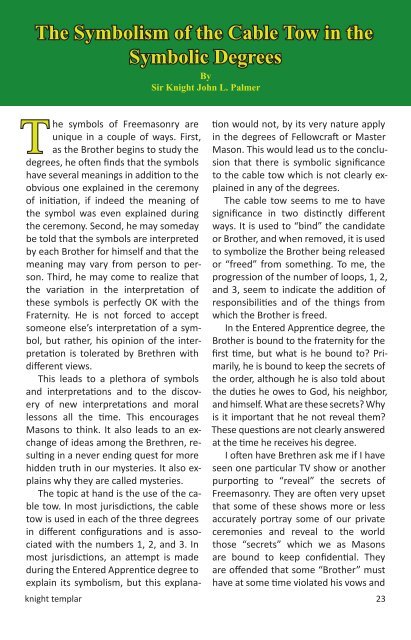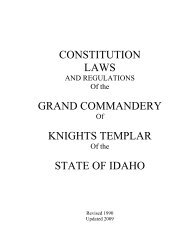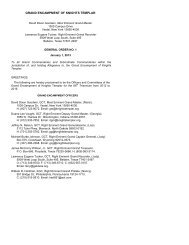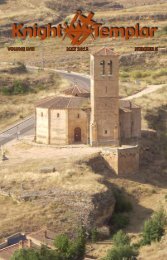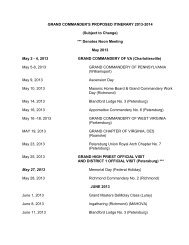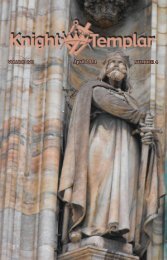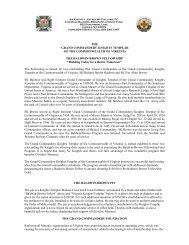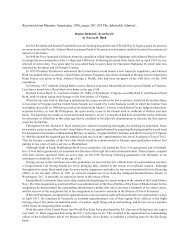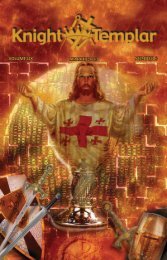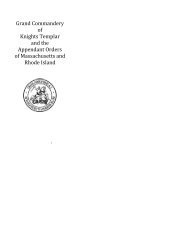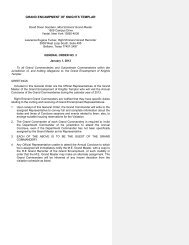september - Grand Encampment, Knights Templar
september - Grand Encampment, Knights Templar
september - Grand Encampment, Knights Templar
You also want an ePaper? Increase the reach of your titles
YUMPU automatically turns print PDFs into web optimized ePapers that Google loves.
The Symbolism of the Cable Tow in the<br />
Symbolic Degrees<br />
By<br />
Sir Knight John L. Palmer<br />
knight templar<br />
The symbols of Freemasonry are<br />
unique in a couple of ways. First,<br />
as the Brother begins to study the<br />
degrees, he often finds that the symbols<br />
have several meanings in addition to the<br />
obvious one explained in the ceremony<br />
of initiation, if indeed the meaning of<br />
the symbol was even explained during<br />
the ceremony. Second, he may someday<br />
be told that the symbols are interpreted<br />
by each Brother for himself and that the<br />
meaning may vary from person to person.<br />
Third, he may come to realize that<br />
the variation in the interpretation of<br />
these symbols is perfectly OK with the<br />
Fraternity. He is not forced to accept<br />
someone else’s interpretation of a symbol,<br />
but rather, his opinion of the interpretation<br />
is tolerated by Brethren with<br />
different views.<br />
This leads to a plethora of symbols<br />
and interpretations and to the discovery<br />
of new interpretations and moral<br />
lessons all the time. This encourages<br />
Masons to think. It also leads to an exchange<br />
of ideas among the Brethren, resulting<br />
in a never ending quest for more<br />
hidden truth in our mysteries. It also explains<br />
why they are called mysteries.<br />
The topic at hand is the use of the cable<br />
tow. In most jurisdictions, the cable<br />
tow is used in each of the three degrees<br />
in different configurations and is associated<br />
with the numbers 1, 2, and 3. In<br />
most jurisdictions, an attempt is made<br />
during the Entered Apprentice degree to<br />
explain its symbolism, but this explanation<br />
would not, by its very nature apply<br />
in the degrees of Fellowcraft or Master<br />
Mason. This would lead us to the conclusion<br />
that there is symbolic significance<br />
to the cable tow which is not clearly explained<br />
in any of the degrees.<br />
The cable tow seems to me to have<br />
significance in two distinctly different<br />
ways. It is used to “bind” the candidate<br />
or Brother, and when removed, it is used<br />
to symbolize the Brother being released<br />
or “freed” from something. To me, the<br />
progression of the number of loops, 1, 2,<br />
and 3, seem to indicate the addition of<br />
responsibilities and of the things from<br />
which the Brother is freed.<br />
In the Entered Apprentice degree, the<br />
Brother is bound to the fraternity for the<br />
first time, but what is he bound to? Primarily,<br />
he is bound to keep the secrets of<br />
the order, although he is also told about<br />
the duties he owes to God, his neighbor,<br />
and himself. What are these secrets? Why<br />
is it important that he not reveal them?<br />
These questions are not clearly answered<br />
at the time he receives his degree.<br />
I often have Brethren ask me if I have<br />
seen one particular TV show or another<br />
purporting to “reveal” the secrets of<br />
Freemasonry. They are often very upset<br />
that some of these shows more or less<br />
accurately portray some of our private<br />
ceremonies and reveal to the world<br />
those “secrets” which we as Masons<br />
are bound to keep confidential. They<br />
are offended that some “Brother” must<br />
have at some time violated his vows and<br />
23


